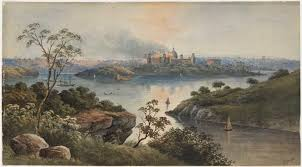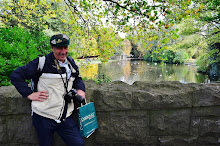N.S.W. State LIbrary
STATE
LIBRARY OF N.S.W. – NEE MITCHELL
Many are the folk that still call it the Mitchell Library
and many are those (me included) who wonder why they changed the name at
all. Still, that wasn’t the only change.
Added to half a dozen times over the decades since 1910, in its present form
it’s a vehicle for much more than just books, which is the reason I called in
on this particular occasion. It was nice
to know that Liz and Phil had travelled from England to open the last incarnation.
David Scott Mitchell, after whom the library was named, was the first noted collector of Australiana and donated his considerable collection to the public.
David Scott Mitchell's coat of armsThe designer of the original building was Colonel Walter Liberty Vernon and, to this day, the Greek influence (fired by Palladio no doubt) can be clearly seen by the lovely Ionic columns at the front entrance, behind the statue of Matthew Flinders. Around the side there’s also a bronze of Flinders’ cat, Trim.
Just beyond them, as you enter, is the marvellous floor
mosaic of the Tasman Map. Between 1939 and 1941, the Melocco Brothers used
45 slabs of 22 mm thick marble, with coloured marble granules and inlays of
brass, to outline the ships and decorative features echoing the floor of the
Burgerzaal (town hall) in Amsterdam. The
map records where Abel Tasman sailed and mapped around 130 years before Cook
even thought of leaving home!
The Book of Kells
Though the overall name was changed, the wing known as Mitchell exists still, where you can view, from above, the legions of book lovers and researchers that still pore over the volumes daily. At key half way points around the top there are some splendid examples of stained glass and, above the north entry, in 1942, the splendid trio of coloured glass was revealed, featuring the 8th century Book of Kells on either side of the reproduction of the letter “B” from the first psalm in the Gifford Psalter, an illuminated prayer book from the Clare Priory in Suffolk (England) dating back to 1250.
The Caxton WindowOn the western side of the library is the Caxton window, honouring William Caxton, who was the first English printer. The image shows Caxton presenting his translation of Recuyell of the Historyes of Troye to his patron Margaret of York, Duchess of Burgundy.
Opposite can be seen windows depicting Chaucer’s Tales and, if all that hasn’t sated you, you could step into the Shakespeare room where the Seven Ages of Man are depicted. None of which is why I originally came here this time.
One of the three Seven Ages of Man panels
No, I’m here, amongst other things, to view the splendid art
gallery that’s emerged from the large stockpile of fine artworks that the
library houses. For too long they’ve been
hidden but now over 300 of them are displayed in a well thought out gallery and
it’s a fascinating step back into the 19th C and the people who
lived in that era.
Von Guerard, Tom Roberts, Arthur Streeton and a host of other well-known painters can be seen here and many of the subjects are even more famous and attired in the couture of the time. Joseph Banks, Caroline Chisholm, Governor Fitzroy and Hans Heysen just to whet your appetite. Indeed, if history is one of your interests, the gallery is a must-see!
Vaucluse by George PeacockThe historic landscapes give an idea of what once was around Sydney Harbour but is now covered in houses while portraits of squatters reflect the times when successful pastoralists deemed it fashionable to have their portraits painted, though the images of squatters might be tainted with history these days.
The Convex Mirror
One of my favourites is “The Convex Mirror” by George
Washington Lambert, painted at a cottage called “Bellwethers” in Surrey,
England. Although the figure at right
rear seems somewhat stilted, I love the scene and the imagination to paint such
a piece.
John Clark Hoyte’s recording of the burning of The Garden Palace in 1882 is a dramatic reminder of this significant event, now largely overlooked in Australia’s history. Built for an International Exhibition, it only lasted 3 years before catching fire and suffering the same fate as ultimately befell Crystal Palace in London. It was a stunning piece of historical architecture whose like was never to be repeated.
Richard Brydges “Landing at Bounty Bay” is a powerful work, recalling the landing of the mutineers on Pitcairn Island where he visited as a captain 35 years later, en route to the Bering Strait, not long before the last survivor, John Adams, passed away. You can’t help but recoil a little at the pounding the small boats are receiving.
Family Group with Canoe by William Pitt Wilshire
The indigenous population is represented in a few works,
smoke rising from a fire beside a stream is one that I recall and there’s
another of a man hiding behind a tree before he attempts to spear a kangaroo. The entry doors also have wonderful bronze
bas reliefs of natives in a variety of poses.
The most moving painting, when you know the provenance, is that of the lovely 23 year old Sophia O’Brien, painted, post mortem, from her death mask, by ex-naval surgeon Maurice Felton. She was the ‘beloved wife’ of a newspaper proprietor, Francis O’Brien, and third daughter of its founder, Edward Smith Hall.
Billy BlueOf all the portraits, the most memorable is that of Billy Blue, an African American enterprising ex-convict whose dress, with top hat, is striking to say the least.
Another feature I admire is the continuous video of how a
painting restoration is done. It’s
extraordinary the lengths that the people who do this work (mostly women) have
to go to. I suspect their number one
attribute is patience!
In other corridors and rooms, freed up after the recent
additions, there are displays such as extremely rare books, dating back
hundreds of years, the Nikon-Walkley press photography awards and a thought
provoking and emotionally moving display of war images, from a touring
exhibition of the National War Museum in Canberra.
Don’t walk in expecting to get out in under an hour, there’s
so much to see!
Labels: Abel Tasman, David Scott Mitchell, N.S.W. Library, Seven Ages of Man, Sophia O'Brien; Bounty Bay, The Caxton window, The convex mirror, Vaucluse


.jpg)

.jpg)
.jpg)



.jpg)
.jpg)
.jpg)


.jpg)
.jpg)
.jpg)


-2.jpg)
-1.jpg)
%20(800x531).jpg)
-2.jpg)

.JPG)
.JPG)
.JPG)
.JPG)
.JPG)
%20sp.JPG)
%20sp-1.jpg)
.JPG)
.JPG)
.JPG)
.JPG)
%20Valvasor.JPG)
.JPG)
.JPG)
.JPG)
.JPG)
.JPG)
.JPG)
.JPG)
.JPG)
%20-%20France%20Preseren%20-%20poet.JPG)
%20-%20Jakov%20Brdar%20-%20Adam%20and%20Eve%20fleeing%20the%20garden%20of%20Eden.JPG)
-1.jpg)
.JPG)
.JPG)
.JPG)
.JPG)
.JPG)
.JPG)
.JPG)
.JPG)
.JPG)
.JPG)
.JPG)
.JPG)
.JPG)
.JPG)
.JPG)
.JPG)
.JPG)

